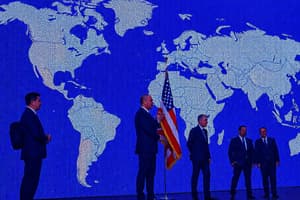Podcast
Questions and Answers
What is emphasized as essential for improving intelligence effectiveness?
What is emphasized as essential for improving intelligence effectiveness?
- Limiting intelligence to military contexts.
- Enhancing communication between analysts and policymakers. (correct)
- Reducing the number of analysts involved.
- Focusing solely on analytical processes.
What does the 'Midway standard' illustrate in Wirtz's discussion?
What does the 'Midway standard' illustrate in Wirtz's discussion?
- The benefits of international collaboration in intelligence.
- The importance of understanding decision-making dynamics in intelligence. (correct)
- The effectiveness of traditional strategic approaches.
- The need for technological advancements in intelligence.
What problem arises from the current state of American intelligence, according to commentators?
What problem arises from the current state of American intelligence, according to commentators?
- Excessive focus on historical intelligence failures.
- Over-reliance on technological resources.
- Unrealistic expectations or rigidity to reforms. (correct)
- Lack of interest in global financial issues.
What is a key product of the National Intelligence Estimate process?
What is a key product of the National Intelligence Estimate process?
What has been a significant criticism of the American intelligence community following major events?
What has been a significant criticism of the American intelligence community following major events?
What aspect is critical for reducing the risk of intelligence failures, according to Wirtz?
What aspect is critical for reducing the risk of intelligence failures, according to Wirtz?
What emerging challenges does the American intelligence community need to consider?
What emerging challenges does the American intelligence community need to consider?
What is the essence of Betts’ paradox as discussed by Wirtz?
What is the essence of Betts’ paradox as discussed by Wirtz?
What is a critical need identified in the discussion of covert action during the Cold War?
What is a critical need identified in the discussion of covert action during the Cold War?
What significant evolution regarding OSINT does the article highlight?
What significant evolution regarding OSINT does the article highlight?
Which challenge associated with OSINT is mentioned in the article?
Which challenge associated with OSINT is mentioned in the article?
How do civil society groups like Bellingcat differ in their classification from traditional OSINT?
How do civil society groups like Bellingcat differ in their classification from traditional OSINT?
What is an implication of the divided definitions of OSINT presented in the article?
What is an implication of the divided definitions of OSINT presented in the article?
What does the U.S. House of Representatives define OSINT as?
What does the U.S. House of Representatives define OSINT as?
What aspect of OSINT is emphasized regarding its integration into methodologies?
What aspect of OSINT is emphasized regarding its integration into methodologies?
What is the primary purpose of differentiating between raw information and OSINT?
What is the primary purpose of differentiating between raw information and OSINT?
What is governance capacity in the context of crisis management?
What is governance capacity in the context of crisis management?
What is a primary focus of trauma-informed educational programs for children?
What is a primary focus of trauma-informed educational programs for children?
How is crisis management defined in the article?
How is crisis management defined in the article?
What role does coordination play in crisis management according to the article?
What role does coordination play in crisis management according to the article?
How do the living conditions in J1 rehabilitation centers compare to those in IDP camps?
How do the living conditions in J1 rehabilitation centers compare to those in IDP camps?
What factor contributes to the increased vulnerability of children in IDP camps?
What factor contributes to the increased vulnerability of children in IDP camps?
What is meant by governance legitimacy in crisis management?
What is meant by governance legitimacy in crisis management?
What challenge do IDP families face regarding the duration of their stay?
What challenge do IDP families face regarding the duration of their stay?
What can undermine effective coordination in crisis management?
What can undermine effective coordination in crisis management?
What is a significant concern communities have regarding returning IDPs?
What is a significant concern communities have regarding returning IDPs?
Which element is critical for developing a cohesive EU security and defense policy?
Which element is critical for developing a cohesive EU security and defense policy?
What is one recommended approach to mitigate stigmatization risks for returning families?
What is one recommended approach to mitigate stigmatization risks for returning families?
What is highlighted as a significant factor in shaping crisis management performance?
What is highlighted as a significant factor in shaping crisis management performance?
Why is equitable assistance important for different war-affected groups?
Why is equitable assistance important for different war-affected groups?
What is one of the lessons suggested for future research regarding the EU's strategic autonomy?
What is one of the lessons suggested for future research regarding the EU's strategic autonomy?
What contribution does Daniel Koehler's work have in the field of CVE?
What contribution does Daniel Koehler's work have in the field of CVE?
What is the primary impact of technological evolution on global politics?
What is the primary impact of technological evolution on global politics?
Which of the following is a negative consequence of technological advancements?
Which of the following is a negative consequence of technological advancements?
What is meant by 'technological practice' in the broader definition of technology?
What is meant by 'technological practice' in the broader definition of technology?
How does technological determinism view the relationship between technology and history?
How does technological determinism view the relationship between technology and history?
What does the critique of limited academic inquiries suggest about technology and global affairs?
What does the critique of limited academic inquiries suggest about technology and global affairs?
What does a narrow definition of technology typically exclude?
What does a narrow definition of technology typically exclude?
What perspective emphasizes the social processes in shaping technology's development?
What perspective emphasizes the social processes in shaping technology's development?
Which of the following best represents the reconciliatory approach to technology discussed in the paper?
Which of the following best represents the reconciliatory approach to technology discussed in the paper?
What is the definition of intimate femicide?
What is the definition of intimate femicide?
Which statistical fact highlights the prevalence of intimate femicide worldwide?
Which statistical fact highlights the prevalence of intimate femicide worldwide?
What role does gender play in the perpetration of intimate femicide?
What role does gender play in the perpetration of intimate femicide?
What does intimate partner homicide (IPH) refer to?
What does intimate partner homicide (IPH) refer to?
What is the significance of the term 'gendered phenomenon' in the context of intimate femicide?
What is the significance of the term 'gendered phenomenon' in the context of intimate femicide?
Why is there a call for more research on male perpetrators of intimate femicide?
Why is there a call for more research on male perpetrators of intimate femicide?
What is one outcome of patriarchal systems regarding intimate femicide?
What is one outcome of patriarchal systems regarding intimate femicide?
What do Frye's narrative typologies propose in the context of intimate femicide?
What do Frye's narrative typologies propose in the context of intimate femicide?
Flashcards
Tech's Impact on Global Society
Tech's Impact on Global Society
Technology's ability to influence various aspects of global society, including economic progress, military strength, and environmental concerns.
Technological Determinism
Technological Determinism
A perspective that views technology as a driving force that autonomously shapes history, independent of human influence.
Social Constructivism (Technology)
Social Constructivism (Technology)
A perspective that highlights the influence of social values, needs, and processes in shaping technology's development and impact.
Technological Practice
Technological Practice
Signup and view all the flashcards
Reconciliatory Perspective (Technology)
Reconciliatory Perspective (Technology)
Signup and view all the flashcards
Digital Divide
Digital Divide
Signup and view all the flashcards
Science and Technology Studies (S&TS)
Science and Technology Studies (S&TS)
Signup and view all the flashcards
Expanding Our Understanding of Technology
Expanding Our Understanding of Technology
Signup and view all the flashcards
Trauma-informed Educational Programs
Trauma-informed Educational Programs
Signup and view all the flashcards
Reintegration
Reintegration
Signup and view all the flashcards
J1 Rehabilitation Center vs. IDP Camps
J1 Rehabilitation Center vs. IDP Camps
Signup and view all the flashcards
Stigmatization and Rejection
Stigmatization and Rejection
Signup and view all the flashcards
Engagement, Education, and Awareness
Engagement, Education, and Awareness
Signup and view all the flashcards
Deradicalization
Deradicalization
Signup and view all the flashcards
Understanding Deradicalization by Daniel Koehler
Understanding Deradicalization by Daniel Koehler
Signup and view all the flashcards
Countering Violent Extremism (CVE)
Countering Violent Extremism (CVE)
Signup and view all the flashcards
Crisis
Crisis
Signup and view all the flashcards
Governance Capacity
Governance Capacity
Signup and view all the flashcards
Governance Legitimacy
Governance Legitimacy
Signup and view all the flashcards
Crisis Management
Crisis Management
Signup and view all the flashcards
Coordination
Coordination
Signup and view all the flashcards
Crisis Challenges
Crisis Challenges
Signup and view all the flashcards
Coordination Issues
Coordination Issues
Signup and view all the flashcards
Influences on Crisis Management
Influences on Crisis Management
Signup and view all the flashcards
Intimate Femicide
Intimate Femicide
Signup and view all the flashcards
Intimate Partner Violence (IPV)
Intimate Partner Violence (IPV)
Signup and view all the flashcards
Gender Dynamics in IPV
Gender Dynamics in IPV
Signup and view all the flashcards
Narrative Typologies (Frye, 1957)
Narrative Typologies (Frye, 1957)
Signup and view all the flashcards
Sociological Excuses (Scott & Lyman, 1968)
Sociological Excuses (Scott & Lyman, 1968)
Signup and view all the flashcards
Continued Research on IPH
Continued Research on IPH
Signup and view all the flashcards
Theoretical Frameworks in Intimate Femicide Research
Theoretical Frameworks in Intimate Femicide Research
Signup and view all the flashcards
Contextualizing IPH
Contextualizing IPH
Signup and view all the flashcards
Covert Action
Covert Action
Signup and view all the flashcards
Hybrid Warfare
Hybrid Warfare
Signup and view all the flashcards
Open-Source Intelligence (OSINT)
Open-Source Intelligence (OSINT)
Signup and view all the flashcards
OSINT Practice
OSINT Practice
Signup and view all the flashcards
Information Overload
Information Overload
Signup and view all the flashcards
Reliability of Sources
Reliability of Sources
Signup and view all the flashcards
Ethical and Legal Scrutiny
Ethical and Legal Scrutiny
Signup and view all the flashcards
Open-Source Investigation (OSINV)
Open-Source Investigation (OSINV)
Signup and view all the flashcards
National Intelligence Estimate (NIE)
National Intelligence Estimate (NIE)
Signup and view all the flashcards
President's Daily Brief (PDB)
President's Daily Brief (PDB)
Signup and view all the flashcards
Betts' Paradox
Betts' Paradox
Signup and view all the flashcards
Comprehensive Intelligence Approach
Comprehensive Intelligence Approach
Signup and view all the flashcards
Midway Standard
Midway Standard
Signup and view all the flashcards
Inevitable Intelligence Failures
Inevitable Intelligence Failures
Signup and view all the flashcards
Holistic Mindset for Intelligence
Holistic Mindset for Intelligence
Signup and view all the flashcards
Repeated Intelligence Failures
Repeated Intelligence Failures
Signup and view all the flashcards
Study Notes
Week 1
- The interplay of science, technology, and security is explored, critiquing current security practices.
- Science and technology are vital tools in maintaining security but are also subjects of security scrutiny.
- The authors argue for a more robust academic response to security issues, particularly following events like 9/11.
- STS scholars face challenges engaging security communities, navigating power dynamics and maintaining researcher objectivity.
- Socio-technical collaboration, the interplay between scientific knowledge and social systems in security, is introduced.
- Collaboration modes can either enhance or stifle critical analyses.
- Reflexivity and shared responsibilities are essential for successful partnerships.
- Three examples are given to show case studies of engagement with security communities
Week 2
- The article analyzes the challenges faced by children associated with ISIS-affiliated families in Iraq, particularly focusing on their rehabilitation and reintegration.
- Over 25,000 Iraqis, mostly women and children, are in al-Hol camp in Syria.
- The Iraqi government is initiating return efforts through rehabilitation programs.
- Bronfenbrenner's bioecological model explains the unique barriers these children face.
- These include familial ties to ISIS, psychological impacts, community reintegration obstacles, and legal frameworks.
- The article argues that these children should be understood through a vulnerability lens, recognizing their potential for recovery with appropriate support systems.
Week 3
- The study investigates the emotional experiences of men who have committed intimate femicides in Latin America.
- It utilizes a micro-sociological perspective.
- 33 open-ended interviews with convicted male perpetrators in Argentina, Bolivia, and Mexico.
- Four primary emotions that characterize these perpetrators are fear, helplessness, pain, and anger.
- The study emphasizes gendered social orders, exploring how emotions are navigated in intimate femicide.
Week 4
- The article discusses the European Union's response to Russia's invasion of Ukraine, highlighting rapid actions and a significant shift towards EU enlargement.
- Ukraine's candidacy for membership in June 2024 symbolizes the EU's commitment to democratic values.
- The article posits that internal EU divisions may hinder a unified approach to enlargement despite cooperative efforts.
- The historical context of EU enlargement and the impact of the war on Ukraine's enlargement agenda is discussed.
- The role of crisis leadership and coalitions are considered in how the EU is responding.
Week 5
- The article explores how governance capacity and legitimacy are essential components of crisis management.
- It discusses that governance capacity refers to a government's ability to mobilize resources, facilitate decision-making, and effectively implement policies.
- Governance legitimacy relates to public trust and perceptions concerning the government's actions.
- The authors also explain that structural features and cultural contexts during crises heavily shape performance.
Week 6
- The article by James J. Wirtz grapples with the persistent issue of intelligence failures.
- The paradox of intelligence failure consists of two main parts: the presence of accurate signals before the failure and the inevitability of these failures.
- Historical examples, such as the Pearl Harbor attack and the 9/11 terrorist attacks, are used to illustrate that relevant information existed prior to specific events.
- The discussion examines how analysts often overlooked relevant information because of ambiguity and organizational shortcomings.
- The author examines the need to reform intelligence practices, emphasizing the need for a shared understanding of threats through collaborative efforts between intelligence analysts and policy makers.
Week 7
- The article explores how global economic networks shape state coercion.
- The United States' withdrawal from the Iran Nuclear Deal and subsequent economic sanctions are examined.
- This illustrates the utilization of economic influence as a tool for global geopolitical power.
- The article emphasizes how the complex interdependence of global economic and information networks creates a new arena for state coercion.
- Traditional security studies emphasized the importance of energy markets, but contemporary analysis also reveals growing importance of finance and information markets.
Studying That Suits You
Use AI to generate personalized quizzes and flashcards to suit your learning preferences.




